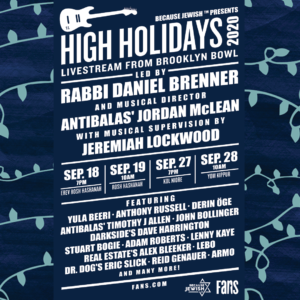There are so many creative holiday options and useful resources out there to make this most unusual Rosh Hashanah meaningful.
Last year, I wrote about Bowl Hashanah in a Jerusalem Post article. Thanks to the generosity of Brooklyn Bowl owner and mensch extraordinaire, Peter Shapiro, a creative musical Rosh Hashanah takes place in this musical venue every year. This year, they will expand, hosting 4 free online services from the Brooklyn Bowl.
Four events—on the first night and first day of Rosh Hashanah (Sept 18 at 7:30 pm ET and Sept 19 at 10 am ET), Kol Nidre (Sept 27 at 7 pm ET)) and Yom Kippur Day (Sept 28 at 10 am ET) will be led by Rabbi Daniel Brenner and musical director and Antibalas co-founder, Jordan McClean. Jeremiah Lockwood, who was a member of Balkan Beat Box and Piedmont Blues musician Carolina Slim's Fraternal Order and has collaborated extensively with Antibalas, the Yeah Yeah Yeahs’ Brian Chase and many others, will serve as musical and spiritual supervisor remotely. Info on the free livestream on Fans.com is available here:
Synagogues are doing all kinds of creative things to bring Rosh Hashanah to the people. Most (especially Reform and Conservative) are offering Zoom only services, while some are offering shortened or blended options including morning services outdoors, or morning services on Zoom with afternoon/evening/tashlich and shofar outside.
Last week, I explored some creative options for Orthodox synagogues, which are not able to use technology on Shabbat and holidays
Earlier this week, I wrote about shuls from all denominations getting together in New York City for “Shofar in the Streets. A wonderful model.
Just today, I came across resources which will surely be useful for families wishing to make Rosh Hashanah meaningful for their children. One is from PJ library with their “High Holidays at Home Guide for Families”—a free download.
My Jewish Learning is offering a similar sounding resource: “How To Celebrate the High Holidays at Home.”
They are also offering “Nine Things You Didn’t Know About Rosh Hashanah.”
Finally for today, I just discovered a very nice, recently released resource which is useful for families of children with disabilities, and for all children! It is a social story from jkidaccess in Philadelphia!
More to come….












